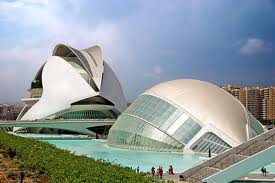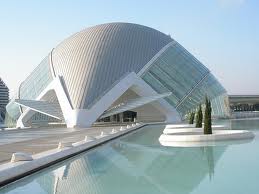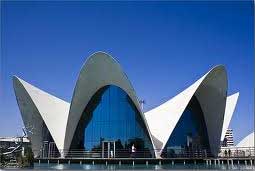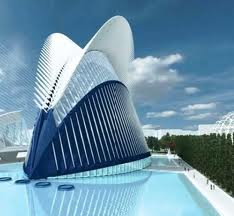Valencia City of the Arts and sciences

The City of the Arts and Sciences in Valencia is an architectural, cultural and entertainment complex designed by Santiago Calatrava and Félix Candela. It was opened in 1998 with the inauguration of L'Hemisfèric. The last component of the group is the Agora, which has functioned since 2009 as an events venue. If you visit Valencia it is just worth taking a look at its innovative and modern architecture. And yet, there's much more to it.
The City of Arts and Sciences of Valencia is located by the end of the old riverbank of the river Tarua, which became a garden in the 1980s. It is today one of the most popular tourist sites in Valencia, and since 2007 it has been listed as one of the 12 Spanish Wonders.
In 1989, the president of the regional government, Joan Lerma, decided to appoint José María López Piñero (History of Science Professor of the Valencia University) to build a scientific museum. Lerma commissioned a team to create the project and visited several venues in other cities, such as London and Munich, in order to elaborate a clearly educationally orientated museum: the atom would be the visitor's guide to show him all the phases of nature.
The Museum would be the centre of a complex, halfway between cultural and touristic, that would help to make of Valencia an 'emblematic city'. However, the enormous nature of the project and the funds needed to finance it caused some political conflict, despite the fact that the enterprise went ahead.
The site works began in 1991, but when the regional government was taken over by the opposition the construction was stopped and the project redefined to include several additional elements, such as the opera house and an oceanographic park. Calatrava redesigned his initial work and present his second project in 1996. He would be in charge of three buildings: L'Hemispheric in the shape of a human eye, the Arts Palace and the Science Museum, while Félix Candela (one of Calatrava's mentors) would design L'Oceanográfic. The works recommenced in 1997 and a year later the first building opened its doors.
City of Arts of Sciences of Valencia: buildings
The complex is formed by six buildings, each hosting a different scientific or artistic activity. Each building has its own entry fee and opening hour, so we suggest you visit the City or Arts and Sciences' website to check what activities are likely to attract you, if you are a short time visitor. However, if you are staying longer in Valencia, we recommend you to visit all of them.

Hemispheric
Hemispheric is a singular and spectacular building, designed by Valencian architect Santiago Calatrava, which represents a human eye: the eye of wisdom. It symbolizes the visitor's observation as they come to discover amazing audiovisual IMAX screenings in the projection room and planetarium. Its overall surface spans 13,000 m². It is Spain's biggest IMAX cinema and it offers many different activities, including fun and scientific educational projections, such as Hubble, Exploring the Universe, a documentary about the STS-125 mission onboard space shuttle Atlantic, or Sea Monsters 3D, a film that reproduces the oceanic world based on discoveries of paleontological digs carried out in the entire world. It's a good idea to check out Hemispheric's schedule to find out the current activities.
Prince Felipe Science Museum
Designed by Calatrava and opened in 2000, this building is unique in the world due to its geometry, structure, materials and the continuous presence of nature. In the museum building, art and engineering are closely intertwined. The museum counts with 26,000 m² of exhibition space distributed in three floors. Each room within is dedicated to a specific area of science and in many cases there are interactive modules visitors can participate with, a very modern concept for a science museum. There are interesting sections dedicated to DNA, another to bio mechanics and there is even a Foucault pendulum, one of the longest in the world.

Oceanographic
The biggest aquarium in Europe, Oceanographic exhibits examples of the main marine ecosystems of the planet: Mediterranean, wetlands, temperate and tropical seas, oceans, the Arctic (including a Beluga whale and walruses!), islands and the Red Sea. Each building in Oceanographic represents one of these eco-systems. The largest tank in the aquarium holds 7 million liters of water while some 30 meters beneath a transparent acrylic tunnel can be crossed to observe amazing species, such as grey sharks, barracudas and shoals of fish that live in our oceans. There is also one of the largest dolphinariums of the world which exhibits educational bottlenose dolphin shows.
Reina Sofía Arts Palace
The opera theatre of Valencia and also the headquarters of the Orchestra of the Valencian Community. It opened in 2005 and the first opera featured was Beethoven's Fidelio. The main room has a capacity for 1481 people, distributed between the plateau and boxes. There is one room reserved for conferences or chamber concerts, an auditorium that can hold 1,500 spectators and, finally, the Teatro Martín y Soler, a theatre located in an adjacent building to the palace, which holds an audience of 400 people.
Umbracale
A vantage point of more than 17,500 m² with an exhibition area from where its possible to see the entire complex, including buildings, pools and garden zones, of the City of the Arts and Sciences of Valencia.

Agora
The new icon the City of Arts and Sciences, Agora is a versatile space which allows to hold all sorts of events. It has a multifunctional space that can hold congresses, conventions, concerts and plays, it can also become an exhibition room.
If you are planning a trip to Spain we recommend you include Valencia in your schedule and visit this amazing complex.



